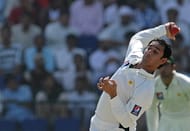
Having upped the ante against suspected illegal bowling actions, the International Cricket Council (ICC) is working to develop a new technology which will allow in-match sensors to detect bowling actions, making the job of spotting an illegal action a purely data based decision.
The project to develop ‘inertial’ sensors, to be worn on upper arm and forearm by the bowlers, is currently in its third and final stage. ICC general manager Geoff Allardice says that the earliest this technology could be used is mid-2015.
On Tuesday, Pakistan off-spinner Saeed Ajmal was suspended from bowling in international matches, after tests revealed that all his deliveries broke the rule which doesn’t allow the bowling arm to be straightened by more than 15 degrees. Ranked No.1 in ODIs, No. 9 in Tests and No. 4 in T20Is, Ajmal is the biggest name to be banned from bowling due to illegal action ever since ICC’s renewed efforts to clamp down on chucking in cricket.
In its board meeting in Melbourne in June, ICC vowed to “revise processes to encourage umpires and referees to identify suspect bowlers with greater confidence, to use the expertise of the bio-mechanics working in this area to assume a greater role during the assessment process, and to allow for ongoing scrutiny of bowlers once they have been identified under the ICC procedures.”
While match officials have been reluctant to report suspect actions, with technological advances, ICC is trying to remove the subjectivity in the matter, making it easier to spot an illegal action.
Sensors – The technology and its challenges
Working with Australian researchers, ICC has developed sensors which can detect the position of the arm at the point of release during a delivery stride. What the sensors lack currently however, is the ability to detect the straightness of the arm during the action, without which the technology remains incomplete.
Another challenging factor in front of ICC is the calibration of the sensors as wearing it on the field by a player may result in its shifting and the data may be compromised.
“At this stage we’re looking to automatically detect the position of the arm at the release with some software that is receiving the signals from the sensors... and how to capture that without any (competing) information,” Allardice told Reuters in an interview recently.
“If you’re in a match situation, the mounting of the sensors of the arm has to be so that they don’t shift position. If they do, then the calibration is disturbed,” he added.
Allardice, in conversation with BBC Sport, talked about the different stages this project has gone through.
“The first stage of the project was just to determine whether the types of sensors can detect an illegal action, which, after a bit of experimentation and number crunching they decided it could.
“The second stage was to package it in a way that we'd be able to use in a net or training environment with some software. We ran some trials in Dubai in February this year, in conjunction with the Under-19 World Cup, where that stage was completed.
“So we're about to embark on the third stage of the process, and the main process is how do we apply that technology in a match environment.”
Apart from mouting the sensors strategically on the bowling arm and making sure they don’t get disturbed by other on-field activities, another question will be the frequency of receiving the data. Whether a ball-by-ball or end of the over, or even post session collection of data is required, will be a topic of debate in near future.
Despite the engineering obstacles, Allardice is confident about the science behind it and remains hopeful of its practicality in the sport.
“The progress with the science is really really encouraging. But there are some challenges in terms of making it practical,” he said.
If this technology works, though it cannot be expected to be accepted worldwide, with apprehensions sure to appear from various members, it may offer invaluable data during practice sessions where a bowler’s action can be scrutinised in much detail.
Not just international cricketers, but younger players too can benefit from it, as it’ll provide them the hard data instead of the subjective view of a coach who may or may not spot an illegal action, and help them work towards changing it.
Looking for fast live cricket scores? Download CricRocket and get fast score updates, top-notch commentary in-depth match stats & much more! 🚀☄️
